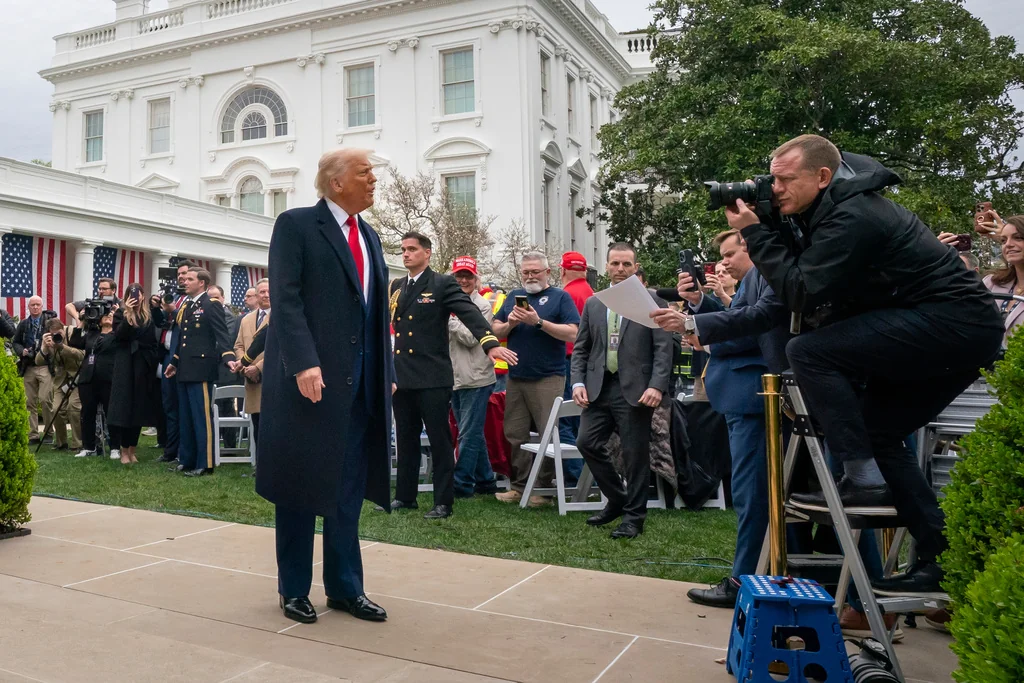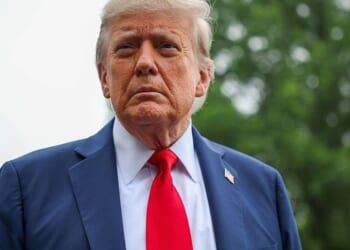The Trump administration wants to convert the automobile sector to an “America First” agenda, but fully onshoring the trillion-dollar industry promises to face sweeping challenges.
Even automotive manufacturers with strong national ties, such as South Carolina’s BMW plant, often rely on a global supply chain for critical components, making President Donald Trump’s mission to make cars completely in the United States at best an objective that would take years to play out.
At worst, Trump’s protectionist policies undermine the competitive dynamics that have raised the country’s standard of living by allowing consumers the ability to purchase quality goods at affordable prices, experts told the Washington Examiner.
It’s a complicated situation that the Trump administration has sought to distill into simple terms, arguing that implementing tariffs on foreign-made auto parts constitutes an important piece of prioritizing U.S. workers and businesses.
“This business model where BMW … comes into Spartanburg, South Carolina, and [has] us assemble German engines and Austrian transmissions,” White House Trade Adviser Peter Navarro said during a CNBC interview in April. “That doesn’t work for America. It’s bad for our economics. It’s bad for our national security. We want them to come here.”
Foreign automakers in South Carolina “get away with murder,” Trump told a Chicago crowd in October, because they “build everything in Germany and then they assemble it here.”
The BMW plant targeted by the Trump administration lies in Spartanburg, a small city in Upstate South Carolina. But even as a company with strong ties to local and state suppliers, the plant is facing uncertainty because it is part of an industry that relies on a global supply chain to produce quality vehicles at affordable prices for consumers.
“When you ask people in abstract about tariffs and competition and fairness, they’re generally for what they see is reciprocity, which you know would support some of these tariffs,” Advancing American Freedom policy director John Shelton said. “But they typically don’t realize or know how much of the even ‘domestic manufacturing’ is deeply, deeply embedded in this international system.”
“In the case of BMW, the last time I checked, it’s something like more than half of all BMWs are imported,” he added. “So these tariffs have a huge impact on American auto manufacturing, even though, you know, manufacturing, in many ways, especially auto manufacturing, is supposed to be the poster boy case for these tariffs.”
Joey Von Nessen, an economist at the University of South Carolina and expert on the state’s auto industry, said that consumers would likely pay the price, at least in the short term, for the Trump administration’s agenda to make cars fully in the U.S. through tariffs.
“From South Carolina’s perspective, the biggest cost, or the biggest downside, would be increased cost to businesses and to consumers,” he argued, noting that manufacturers would see costs increase for raw materials, and likely pass those costs on to customers in the form of higher prices.
“That’s going to impact the demand for these businesses, so if you look at an automotive manufacturer … then how will that impact the demand for the vehicles that they are selling?” Nessen questioned. “That depends on the individual business, but it may be the case that if the costs rise, they have to change their production schedules, or perhaps look at changing their strategy for sales.”
Plant Spartanburg is now the largest single BMW production facility in the world. It has been the largest automotive exporter by value in the U.S. for over a decade, with its export value in 2024 totaling over $10 billion. In 2024, nearly 50% of BMW vehicles sold in the U.S. came from Plant Spartanburg.
The plant has fueled South Carolina’s economy and gained traction nationally. Since its inception, the German-based auto company has invested nearly $15 billion in the Upstate operation. Today, the Spartanburg plant generates $27 billion yearly, alongside $3.1 billion in wages and salaries. The Upstate plant now supports nearly 43,000 jobs across South Carolina, including more than 11,000 associates at the Upstate location. It also fuels over 120,000 jobs across the U.S. and contributes over $43 billion to the U.S. economy annually.
The plant has relied on its supply chain web, much of which is based in-state, to propel its success. It invests heavily in logistics to build a flexible supply chain with unusually strong ties to local and domestic companies, regularly using over 500 Palmetto State suppliers.
“Every 10 jobs that are created in South Carolina, in the automotive industry, we see an additional 25 jobs created elsewhere in the state, so for a total of 35, and the reason for that, for that multiplier effect, is because of the large supply chain,” Nessen said.
However, foreign countries supply up to 45% of the trim parts for each car, even at BMW’s Spartanburg location, with around 20% of the plant’s total components coming from outside North America. Common parts such as powertrains, drivetrains, engines, and transmissions are commonly produced in Europe.
Nessen said he doesn’t think it’s “realistic” to expect BMW’s supply chain to be based entirely in the U.S., “because of the global supply chain and the way that the manufacturing industry is interconnected globally.”
“We don’t have the capabilities to produce, to produce everything, and so we do rely on other countries that produce certain materials and components more efficiently, and [in] some cases, they produce them in a way that the U.S. can’t, at least not currently,” the USC professor said.
The Trump administration has plowed ahead with its goal of converting the automobile industry to an “America First” agenda, rolling out a 25% tariff on foreign-made car parts that began last month. Although Trump softened aspects of the levy to allow manufacturers time to onshore critical components, the tariffs have a sweeping effect, taxing companies for importing pieces from powertrain components to car seats.
During a press conference in the Oval Office last month, Trump said he wanted automakers to build entire vehicles in the U.S. using all domestic parts, instead of importing any components from abroad.
“It used to bother me, they make a part in Canada, a part in Mexico, a part in Europe, and sent all over the place, and nobody knew what the hell was happening,” Trump said. “But over the next year, they’ve got to have the whole thing built in America. That’s what we want.”
Experts such as Shelton have argued that the president’s protectionist policies could erode the “American dream.” Free trade allows for global sourcing, promotes a competitive marketplace where companies jostle to drive the cheapest possible production of quality goods, and expands access to a higher standard of living for the average consumer.
However, the Trump administration has inferred that it is worth risking lifestyle downgrades, especially over the short term, to compel auto manufacturers and other companies to invest more heavily in domestic suppliers. Last month, Trump implied that people affected by higher prices caused by protectionism could adapt their buying behavior and get by with fewer goods. He suggested that diversity of choice in the marketplace is little more than choice overload.
“All I’m saying is that a young lady, a 10-year-old girl, 9-year-old girl, 15-year-old girl, doesn’t need 37 dolls,” Trump recently told reporters aboard Air Force One. “She could be very happy with two or three or four or five.”
“They don’t need to have 250 pencils… They can have five,” the president said during an NBC interview that aired the same day. “I’m basically saying we’re not going to waste money on a trade deficit with China for things we don’t need,” he added.
But while the Trump administration appears to be operating on the premise that less is more if it’s made in the U.S., Shelton disagrees, based on patterns of purchase behaviors he’s observed in Anocastia, a poverty-stricken area in Washington, D.C., where he lived for years.
“The thing about Anacostia is most people don’t have much money, but they have really, really nice cars. And so it’s not clear to me that if you make things more expensive, you make it so people can only afford, or should only be able to afford, two to three dolls, that that’s actually going to change their behavior, and then they’re gonna, like, balance their household budgets and like all because we put tariffs on these things,” he said.
Rather than radically altering consumer behavior or putting U.S. workers first, Shelton suggested that sweeping tariffs designed to force companies to fully onshore operations often stifle the American dream.
This thought is echoed by Dr. Wayne Winegarden, an economist at the Pacific Research Institute, who said that global supply chains have played a major role in helping companies such as BMW produce “a really good car at really good prices.”
“That’s why our standard of living over time — we’re living better than our parents. Our parents would have lived better than our grandparents,” he said. “And you know our goal, hopefully, is that our children will live better than us, [but] we’re in a bit of a question mark on that one. So, you know, the global supply chains really make things more efficient, and when they do that, they actually create more jobs here because our dollar goes farther.”
On a practical level, Winegarden said it’s likely not feasible to onshore companies such as BMW that rely on a global supply chain.
“It takes years to build a plant, especially if you don’t even have it under construction. You gotta site it out. You gotta get all the permitting,” he said. “Even if it’s just expanding sites that we have.”
“And so there’s just this idea that we can slap a tariff on, and next month, we’ll be producing all these things that were being bought overseas … [it’s] just naive, and that’s not the way the world works,” Winegarden continued. “It’s just not possible to take something as complicated as a global supply chain, and have it turn on a dime.… It takes time, you know, and that’s something that, again, Peter Navarro and President Trump really seem to kind of gloss over.”
He warned that history shows tariffs don’t necessarily pay off in terms of economic benefit.
“If you go back to the 1950s, where actually Latin America was wealthier than East Asia, and Latin America used tariffs to protect their industries, and Asia engaged in the world. Fast forward to today. Latin America is poorer than they were then. East Asia has some of the highest per capita incomes in the world,” Winegarden said.
On seeking to increase the presence of supply chains in the U.S., Nessen says it is possible to “move in that direction,” and benefits could come as well. But results would take time, and that could come at a political price, the USC auto expert said.

TRUMP SAYS CHINA TRADE DEAL IS ‘DONE’ WITH TARIFFS SET AT 55%
“Potential benefits could arrive to the extent that we see additional manufacturers looking to relocate to the United States, or manufacturers that expand because the tariffs could potentially limit foreign competition,” he said. “That can take, in some cases, several years, because it takes a long time for a company that may be looking to invest in the U.S. to set up shop and to begin to begin operating.”
“One of the challenges with tariffs is that the costs show up right away, but the benefits tend to lag,” Nessen added. “The political question is, is it worth those additional costs, whatever those turn out to be, in order to get that supply chain more focused and get a greater presence of that supply chain in the United States?”
















